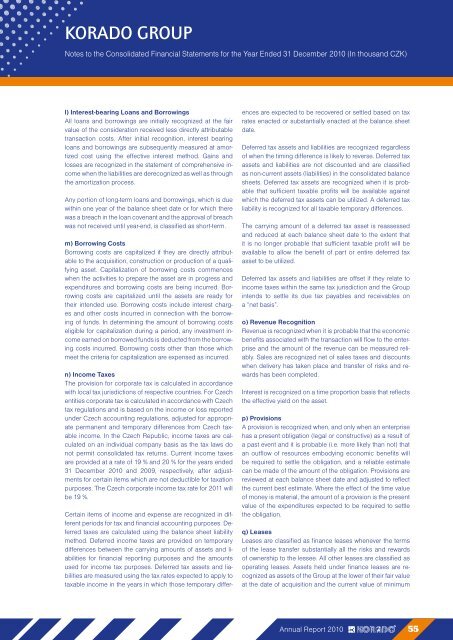ANNUAL REPORT - KORADO, as
ANNUAL REPORT - KORADO, as
ANNUAL REPORT - KORADO, as
Create successful ePaper yourself
Turn your PDF publications into a flip-book with our unique Google optimized e-Paper software.
<strong>KORADO</strong> GROUP<br />
Notes to the Consolidated Financial Statements for the Year Ended 31 December 2010 (In thousand CZK)<br />
l) Interest-bearing Loans and Borrowings<br />
All loans and borrowings are initially recognized at the fair<br />
value of the consideration received less directly attributable<br />
transaction costs. After initial recognition, interest bearing<br />
loans and borrowings are subsequently me<strong>as</strong>ured at amortized<br />
cost using the effective interest method. Gains and<br />
losses are recognized in the statement of comprehensive income<br />
when the liabilities are derecognized <strong>as</strong> well <strong>as</strong> through<br />
the amortization process.<br />
Any portion of long-term loans and borrowings, which is due<br />
within one year of the balance sheet date or for which there<br />
w<strong>as</strong> a breach in the loan covenant and the approval of breach<br />
w<strong>as</strong> not received until year-end, is cl<strong>as</strong>sified <strong>as</strong> short-term.<br />
m) Borrowing Costs<br />
Borrowing costs are capitalized if they are directly attributable<br />
to the acquisition, construction or production of a qualifying<br />
<strong>as</strong>set. Capitalization of borrowing costs commences<br />
when the activities to prepare the <strong>as</strong>set are in progress and<br />
expenditures and borrowing costs are being incurred. Borrowing<br />
costs are capitalized until the <strong>as</strong>sets are ready for<br />
their intended use. Borrowing costs include interest charges<br />
and other costs incurred in connection with the borrowing<br />
of funds. In determining the amount of borrowing costs<br />
eligible for capitalization during a period, any investment income<br />
earned on borrowed funds is deducted from the borrowing<br />
costs incurred. Borrowing costs other than those which<br />
meet the criteria for capitalization are expensed <strong>as</strong> incurred.<br />
n) Income Taxes<br />
The provision for corporate tax is calculated in accordance<br />
with local tax jurisdictions of respective countries. For Czech<br />
entities corporate tax is calculated in accordance with Czech<br />
tax regulations and is b<strong>as</strong>ed on the income or loss reported<br />
under Czech accounting regulations, adjusted for appropriate<br />
permanent and temporary differences from Czech taxable<br />
income. In the Czech Republic, income taxes are calculated<br />
on an individual company b<strong>as</strong>is <strong>as</strong> the tax laws do<br />
not permit consolidated tax returns. Current income taxes<br />
are provided at a rate of 19 % and 20 % for the years ended<br />
31 December 2010 and 2009, respectively, after adjustments<br />
for certain items which are not deductible for taxation<br />
purposes. The Czech corporate income tax rate for 2011 will<br />
be 19 %.<br />
Certain items of income and expense are recognized in different<br />
periods for tax and financial accounting purposes. Deferred<br />
taxes are calculated using the balance sheet liability<br />
method. Deferred income taxes are provided on temporary<br />
differences between the carrying amounts of <strong>as</strong>sets and liabilities<br />
for financial reporting purposes and the amounts<br />
used for income tax purposes. Deferred tax <strong>as</strong>sets and liabilities<br />
are me<strong>as</strong>ured using the tax rates expected to apply to<br />
taxable income in the years in which those temporary differ-<br />
ences are expected to be recovered or settled b<strong>as</strong>ed on tax<br />
rates enacted or substantially enacted at the balance sheet<br />
date.<br />
Deferred tax <strong>as</strong>sets and liabilities are recognized regardless<br />
of when the timing difference is likely to reverse. Deferred tax<br />
<strong>as</strong>sets and liabilities are not discounted and are cl<strong>as</strong>sified<br />
<strong>as</strong> non-current <strong>as</strong>sets (liabilities) in the consolidated balance<br />
sheets. Deferred tax <strong>as</strong>sets are recognized when it is probable<br />
that sufficient taxable profits will be available against<br />
which the deferred tax <strong>as</strong>sets can be utilized. A deferred tax<br />
liability is recognized for all taxable temporary differences.<br />
The carrying amount of a deferred tax <strong>as</strong>set is re<strong>as</strong>sessed<br />
and reduced at each balance sheet date to the extent that<br />
it is no longer probable that sufficient taxable profit will be<br />
available to allow the benefit of part or entire deferred tax<br />
<strong>as</strong>set to be utilized.<br />
Deferred tax <strong>as</strong>sets and liabilities are offset if they relate to<br />
income taxes within the same tax jurisdiction and the Group<br />
intends to settle its due tax payables and receivables on<br />
a “net b<strong>as</strong>is”.<br />
o) Revenue Recognition<br />
Revenue is recognized when it is probable that the economic<br />
benefits <strong>as</strong>sociated with the transaction will flow to the enterprise<br />
and the amount of the revenue can be me<strong>as</strong>ured reliably.<br />
Sales are recognized net of sales taxes and discounts<br />
when delivery h<strong>as</strong> taken place and transfer of risks and rewards<br />
h<strong>as</strong> been completed.<br />
Interest is recognized on a time proportion b<strong>as</strong>is that reflects<br />
the effective yield on the <strong>as</strong>set.<br />
p) Provisions<br />
A provision is recognized when, and only when an enterprise<br />
h<strong>as</strong> a present obligation (legal or constructive) <strong>as</strong> a result of<br />
a p<strong>as</strong>t event and it is probable (i.e. more likely than not) that<br />
an outflow of resources embodying economic benefits will<br />
be required to settle the obligation, and a reliable estimate<br />
can be made of the amount of the obligation. Provisions are<br />
reviewed at each balance sheet date and adjusted to reflect<br />
the current best estimate. Where the effect of the time value<br />
of money is material, the amount of a provision is the present<br />
value of the expenditures expected to be required to settle<br />
the obligation.<br />
q) Le<strong>as</strong>es<br />
Le<strong>as</strong>es are cl<strong>as</strong>sified <strong>as</strong> finance le<strong>as</strong>es whenever the terms<br />
of the le<strong>as</strong>e transfer substantially all the risks and rewards<br />
of ownership to the lessee. All other le<strong>as</strong>es are cl<strong>as</strong>sified <strong>as</strong><br />
operating le<strong>as</strong>es. Assets held under finance le<strong>as</strong>es are recognized<br />
<strong>as</strong> <strong>as</strong>sets of the Group at the lower of their fair value<br />
at the date of acquisition and the current value of minimum<br />
Annual Report 2010 55





